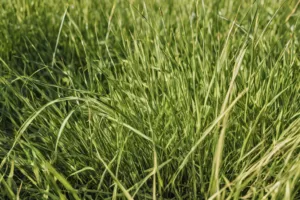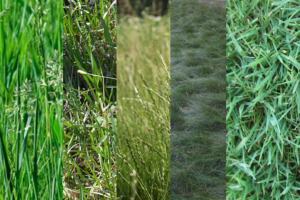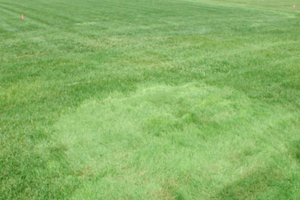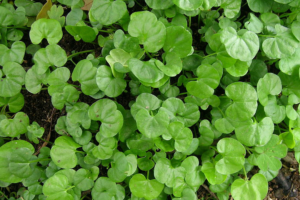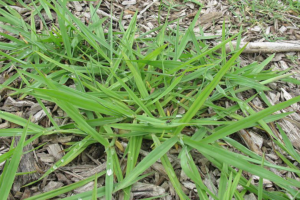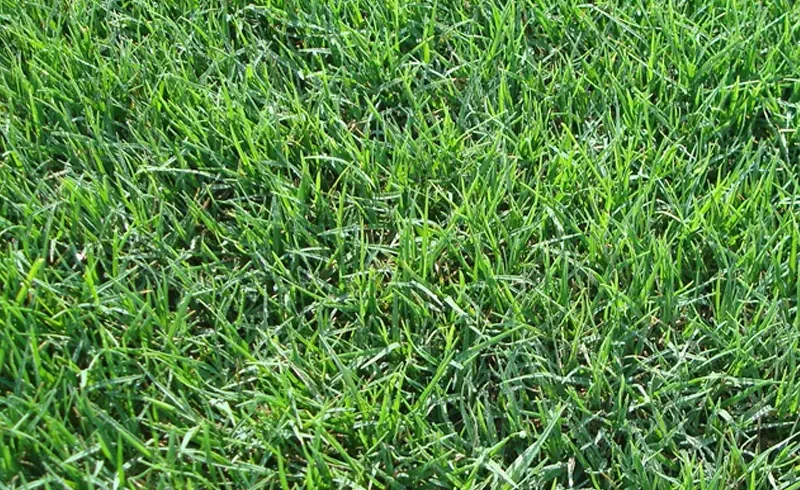
Introduction
Understanding Warm Climate Lawns
- Warm climates present unique opportunities and challenges for lawn care enthusiasts. Characterized by hot temperatures and often accompanied by varying humidity levels, these climates require specific grass types that can thrive under such conditions. Unlike cool-season grasses, which flourish in milder temperatures, warm-season grasses are adapted to grow in heat, often dormant in cooler months. Understanding the nature of warm climates and how they affect grass growth is the first step in creating a lush and vibrant lawn.
- Choosing the right grass type for a warm climate is about aesthetics, sustainability, and resilience. Warm-season grasses are naturally adapted to conserve water, withstand heat, and resist diseases common in hot weather. Selecting the right grass ensures your lawn remains green and healthy, even as temperatures soar. It also means less maintenance, fewer resources, and a lawn that complements the region’s natural ecosystem.
The Challenges and Opportunities
- Challenges in warm climate lawn care can range from water scarcity to pest infestations. The heat can stress the grass, leading to brown patches and increased disease susceptibility. Watering needs can be higher, but at the same time, water conservation becomes crucial, especially in regions prone to drought. Pests such as chinch bugs and grubs may also be more prevalent. Understanding these challenges is essential for effective lawn care, as it allows for proactive measures and timely interventions.
- Despite the challenges, warm climates offer exciting opportunities for creating stunning lawns. The variety of warm-season grasses allows homeowners to choose from different textures, colors, and growth patterns. The options are diverse, from the fine blades of Bermuda grass to the lush green of St. Augustine. Warm climates also mean longer growing seasons, providing more time to enjoy the outdoor spaces. With the proper knowledge, tools, and grass type, a warm climate lawn can be a thriving oasis, providing shade, beauty, and a touch of nature right at home.
The introduction sets the stage for exploring the top 5 grass types for warm climates. It provides context, highlights the unique characteristics of warm climates, and outlines the challenges and opportunities of lawn care in such regions. The following sections will detail each grass type, offering insights, tips, and guidance for homeowners looking to create or maintain a warm climate lawn.
Understanding Grass Types for Warm Climates
Characteristics of Warm-Season Grasses
- Warm-season grasses have distinct traits that set them apart from their cool-season counterparts. These grasses have evolved to thrive in regions with high temperatures and extended periods of sunlight. One of the primary characteristics of warm-season grasses is their ability to thrive during the hot summer months. Their growth slows down or goes dormant during the cooler winter months, conserving energy and resources.
- The physical attributes of these grasses also reflect their adaptation to warm climates. They often have broader leaves, allowing more photosynthesis in bright sunlight. Their root systems are generally deep and extensive, enabling them to access water from deeper soil layers during dry spells. This deep-rooted nature not only aids in drought resistance but also helps stabilize the soil, preventing erosion. Additionally, warm-season grasses have a unique way of producing food (photosynthesis) that’s more efficient in high temperatures and intense sunlight.
Climate Considerations
- Temperature is a defining factor for warm-season grasses but is not the only consideration. Rainfall patterns, humidity levels, and soil types are crucial in determining which grass will thrive in a particular region. For instance, some warm-season grasses prefer the humid conditions of the southeastern United States, while others are better suited for the arid climates of the southwest.
- Regional variations within warm climates can be significant. For instance, coastal areas might have milder temperatures but higher humidity, while inland regions might experience hotter temperatures and drier conditions. Soil types can also vary, with some areas having sandy soils and others having clayey or loamy soils. Understanding these nuances is essential when selecting the right grass type. It ensures that the chosen grass survives and thrives, creating a lush and resilient lawn that complements the local climate and ecosystem.
Warm climates, while challenging, offer a diverse range of grass types, each with its own set of advantages and requirements. Homeowners can make informed decisions by understanding these grasses’ characteristics and a region’s specific climate considerations. The goal is to create a beautiful and sustainable lawn, requiring minimal resources and maintenance. The subsequent sections will delve into the top 5 grass types for warm climates, providing detailed insights into their care, maintenance, and benefits.
Bermuda Grass
Overview and Characteristics
- Bermuda Grass, scientifically known as Cynodon dactylon, is one of the most popular choices for warm climates, and for a good reason. This grass type is known for its robust nature and ability to withstand high temperatures. Originating from the African savannah, Bermuda Grass has evolved to thrive in regions with intense heat and sunlight. It’s OK to medium texture, and deep green makes it a favorite among homeowners looking for a dense, carpet-like lawn.
- One of the standout features of Bermuda Grass is its aggressive growth pattern. This grass spreads through rhizomes (underground stems) and stolons (above-ground stems), allowing it to establish quickly and recover from damage efficiently. This rapid growth, while an advantage, can also be a challenge, as Bermuda Grass can invade flower beds and other areas if not kept in check. Its deep-rooted system, which can reach several feet into the ground, provides it with resilience against drought and ensures stability in the soil.

Maintenance and Care
- Mowing is an essential aspect of Bermuda Grass care. Due to its rapid growth, regular mowing is required to keep it looking neat. Keeping the grass height between 1 to 1.5 inches is recommended for a dense, carpet-like appearance. A sharp mower blade ensures clean cuts, preventing the grass tips from turning brown. Leaving the clippings on the lawn after mowing is also advisable, as they decompose and return valuable nutrients to the soil.
- Watering and fertilization are other crucial components of Bermuda Grass care. While the grass is drought-resistant, it benefits from deep and infrequent watering. This encourages the roots to grow deeper, further enhancing their drought tolerance. As for fertilization, Bermuda Grass has moderate to high nutrient requirements. A balanced fertilizer, applied during the active growing season, ensures lush growth and vibrant green color. It’s also essential to look for common pests like Bermuda Grass mites and diseases like spring dead spots, addressing them promptly to maintain a healthy lawn.
Bermuda Grass is a top choice for warm climates with its resilience and beauty. However, like all grass types, it requires specific care to remain healthy and vibrant. By understanding its characteristics and maintenance needs, homeowners can enjoy a lush, green lawn that meets the challenges of warm climates.
Zoysia Grass
Overview and Characteristics
- Zoysia Grass is a versatile and attractive option for warm climates. Native to Asia, this grass type has made a significant mark in various parts of the world, especially in the warmer regions of the United States. Zoysia is known for its fine to medium texture and ability to create a dense, carpet-like lawn. Its deep green hue and soft texture make it a favorite for residential and commercial landscapes.
- One of the defining features of Zoysia Grass is its tolerance to various conditions. It can withstand heat, drought, and even moderate shade, making it a flexible choice for diverse landscapes. Its dense growth pattern provides a lush appearance and helps crowd out weeds, reducing the need for frequent weeding. Additionally, Zoysia’s deep-rooted system ensures it can access moisture and nutrients from deeper soil layers, further enhancing its resilience.
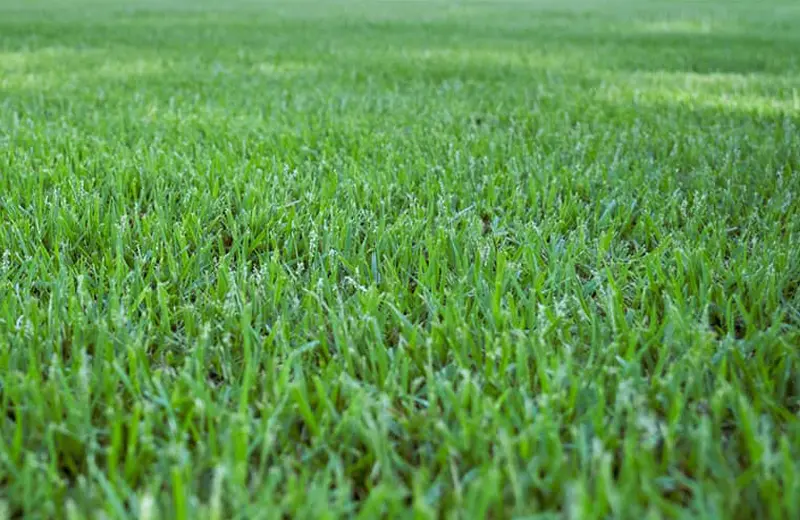
Maintenance and Care
- Mowing is crucial for maintaining the beauty of a Zoysia lawn. Given its dense growth, regular mowing helps keep the lawn neat and promotes even growth. The recommended mowing height for Zoysia is between 1 to 2 inches. It’s essential to use sharp blades to prevent tearing the grass, which can lead to brown tips and potential disease entry points.
- Watering and fertilization practices for Zoysia are straightforward. While the grass is drought-tolerant, it benefits from regular watering, especially during dry spells. Deep and infrequent watering is recommended, promoting profound root growth. Regarding fertilization, a balanced fertilizer applied during the growing season ensures optimal growth and color. It’s also essential to monitor for common pests like billbugs and diseases like brown patches, addressing them promptly to ensure the lawn remains healthy.
With its adaptability and aesthetic appeal, Zoysia Grass offers homeowners a reliable and attractive option for warm climates. Its low maintenance requirements and ability to thrive in diverse conditions make it a top choice for those looking to create a lush, green oasis in their outdoor spaces. Proper care and understanding of its needs ensure that a Zoysia lawn remains vibrant and healthy throughout the year.
St. Augustine Grass
Overview and Characteristics
- St. Augustine Grass, known scientifically as Stenotaphrum secundatum, is a popular choice for warm coastal areas, especially in the southern United States. Its broad, flat blades and deep blue-green hue make this grass type easily recognizable. It’s particularly well-suited for areas with mild winter temperatures and has a high salt tolerance, making it an ideal choice for lawns near the ocean.
- One of the standout attributes of St. Augustine Grass is its shade tolerance. While most warm-season grasses require a lot of sunlight, St. Augustine can thrive even in areas with partial shade. This makes it versatile for landscapes with trees, shrubs, and other elements that might cast shadows. Its robust growth pattern allows it to establish quickly, creating a thick mat that effectively crowds out most weeds.

Maintenance and Care
- Mowing is a fundamental aspect of St. Augustine’s care. Given its rapid growth, especially during the warm months, regular mowing helps maintain a neat appearance and promotes healthy growth. The ideal mowing height for St. Augustine ranges between 2.5 to 4 inches, depending on the specific variety and the homeowner’s aesthetic preference. As always, using sharp mower blades is crucial to ensure clean cuts and prevent damage to the grass.
- Watering and fertilization practices for St. Augustine are pivotal for its health and vibrancy. While the grass is relatively drought-tolerant once established, it benefits from regular watering, especially during prolonged dry periods. Deep watering encourages the roots to grow deeper, enhancing the grass’s resilience. Fertilization must vary based on soil quality, but a balanced fertilizer applied in the spring and late summer usually suffices. It’s also essential to be vigilant about pests like chinch bugs and diseases like gray leaf spots, taking timely measures to address them.
St. Augustine Grass is a favorite for many homeowners in warm climates with its lush appearance and adaptability. Its ability to thrive in varied light conditions and its resilience against common challenges make it a reliable choice. With proper care and an understanding of its unique requirements, a St. Augustine lawn can be a beautiful and enduring feature of any landscape.
Centipede Grass
Overview and Characteristics
- Centipede Grass, scientifically termed Eremochloa ophiuroides, is often called the “lazy man’s grass” due to its low maintenance requirements. Native to China and Southeast Asia, this grass type has become a staple in many parts of the southern United States, particularly in areas with acidic soils. Its light green color and coarse texture give it a distinct appearance, making it easily recognizable among other grass types.
- A defining feature of Centipede Grass is its slow growth rate. Unlike other warm-season grasses that might require frequent mowing, Centipede Grass grows leisurely, reducing the need for regular trimming. Its ability to thrive in acidic soils is another advantage, making it suitable for areas where other grass types might struggle. Centipede Grass has a shallow root system, which means it can establish quickly in the right conditions.
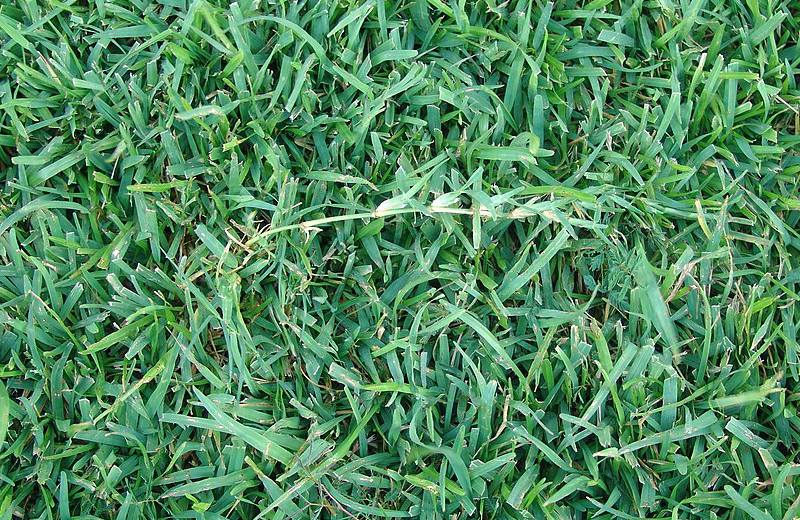
Maintenance and Care
- Mowing requirements for Centipede Grass are relatively minimal due to its slow growth. However, keeping the grass height between 1 to 2 inches is recommended when mowing is necessary. This height ensures the grass remains healthy and reduces the risk of scalping, which can stress the grass and lead to brown patches. As with other grass types, sharp mower blades are essential to ensure clean cuts.
- Watering and fertilization practices for Centipede Grass are straightforward. While the grass can withstand periods of drought, it benefits from occasional deep watering, especially during extended dry spells. Over-fertilization can be detrimental to Centipede Grass, so applying fertilizer sparingly is essential. A light application of a balanced fertilizer once a year, typically in the spring, is usually sufficient. It’s also crucial to monitor for common pests like white grubs and diseases like dollar spot, addressing them as needed.
Centipede Grass, with its low maintenance needs and unique characteristics, offers homeowners a hassle-free option for warm climates. Its adaptability to various soil types and its resilience against common lawn challenges make it a reliable choice. With minimal care and attention, a Centipede Grass lawn can provide a green and pleasant outdoor space for relaxation and recreation.
Buffalo Grass
Overview and Characteristics
- Buffalo Grass, known scientifically as Bouteloua dactyloides, is an actual prairie grass originating in North America. This grass type has a rich history, having sustained vast herds of buffalo and other wildlife for centuries. Today, it’s recognized as a low-maintenance, drought-tolerant grass suitable for warm climates, especially in areas with limited water availability.
- Being a native prairie grass, Buffalo Grass has evolved to thrive in the challenging conditions of the American Great Plains. This means it’s naturally equipped to handle hot temperatures, strong winds, and sporadic rainfall. Its deep root system, which can extend several feet into the ground, allows it to access moisture from deeper soil layers, making it incredibly resilient during dry spells.
Appearance, Growth Habits, and Ideal Conditions
- Buffalo Grass boasts a fine texture and a soft blue-green hue that can turn slightly golden during the dormant winter months. Its growth pattern is unique; instead of growing tall, it spreads outwards, creating a dense mat that’s soft to the touch. This spreading nature makes it an excellent choice for ground cover, especially in areas where erosion control is a concern.
- Ideal conditions for Buffalo Grass include full sunlight and well-draining soil. While it can tolerate some shade, its growth is most vibrant in sunny areas. As for soil, while Buffalo Grass is adaptable to various types, it thrives in slightly alkaline conditions. Its natural habitat is the open plains, so it’s used to wide-open spaces and can struggle if crowded out by other more aggressive grass types or weeds.

Maintenance and Care
- Mowing requirements for Buffalo Grass are minimal. Given its natural low-growing habit, frequent mowing is optional. However, occasional trimming can help maintain a neat appearance, especially if you want a manicured lawn look. Keeping the grass height between 2 to 3 inches is advisable when mowing.
- Watering, fertilizing, and disease control are straightforward for Buffalo Grass. While it’s exceptionally drought-tolerant, occasional deep watering during extended dry periods can help maintain its vibrant color. Fertilization needs are minimal, with a light application once a year sufficient for most lawns. As for diseases, Buffalo Grass is relatively resistant, but it’s still essential to monitor for common lawn diseases and address them promptly.
Pros and Cons
- Benefits of Buffalo Grass include its drought tolerance, low maintenance requirements, and ability to create a dense, weed-resistant mat. Its deep root system not only aids in water conservation but also helps in stabilizing the soil, making it an excellent choice for erosion-prone areas. Its soft texture and unique color make it a visually appealing lawn option.
- Potential drawbacks include its slow establishment rate, especially from seed. It can also struggle in heavily shaded areas or in soils that are too rich. While Buffalo Grass is resistant to many pests and diseases, it’s not entirely immune, so regular monitoring is essential. Some homeowners might also find its dormant golden hue during winter less appealing compared to the vibrant greens of other grass types.
With its unique characteristics and historical significance, Buffalo Grass offers homeowners a sustainable and attractive option for warm climates. Its adaptability to challenging conditions and aesthetic appeal make it a top choice for creating a resilient and beautiful lawn.
Choosing the Right Grass for Your Warm Climate Lawn
Assessing Your Lawn’s Needs
- Soil Testing, Sunlight, and Water Availability: Before selecting a grass type for your warm-climate lawn, assessing your landscape’s specific needs and conditions is essential. Soil testing provides valuable insights into your soil’s pH level, nutrient content, and texture, allowing you to choose a grass type well-suited to your soil conditions. Sunlight is another crucial factor, as different grass types have varying sunlight requirements. Some grasses thrive in full sun, while others can tolerate partial shade. Understanding the sunlight patterns in your lawn ensures that you select grass that will thrive in your specific light conditions.
- Water availability is crucial, especially in warm climates with limited water resources. Assessing the water availability in your region and your ability to provide consistent irrigation (if needed) helps select a grass type that aligns with the local water conditions. Drought-tolerant grasses like Buffalo Grass might be preferable in arid regions, while other grass types might be suitable for areas with more consistent rainfall or irrigation options.
Considerations for Mixing Grass Types
- Pros and Cons of Mixing Different Warm-Season Grasses: Mixing different grass types can create a unique and resilient lawn, but it’s challenging. On the positive side, mixing grass types can enhance the visual appeal of your lawn, providing different textures and shades of green. It can also increase the lawn’s resilience, as different grass types might have complementary strengths and weaknesses. For example, one grass type might be drought-tolerant, while another might be more resistant to pests.
- On the downside, mixing grass types can complicate maintenance. Different grasses might have varying mowing, watering, and fertilization needs, making it challenging to provide consistent care that meets the needs of all the grass types in the mix. Some grass types might outcompete others, leading to an uneven appearance. Careful consideration and planning are required when mixing grass types to ensure they are compatible and achieve the desired aesthetic and functional outcomes.
Professional Consultation and Installation
- When and Why to Seek Professional Help: While many homeowners take pride in selecting and installing their lawns, professional consultation, and installation can provide valuable benefits. Professionals have the expertise to accurately assess your lawn’s specific conditions, including soil quality, sunlight patterns, and water availability. They can recommend the best grass types for your situation and even create custom blends that meet your aesthetic and functional goals.
- Professional installation ensures the grass is planted correctly, with proper soil preparation, seeding or sodding, and initial care. This can lead to quicker establishment and a healthier, more vibrant lawn in the long run. Professionals can also provide ongoing maintenance advice and services, helping you navigate the unique challenges of your chosen grass types. While professional consultation and installation might involve additional costs, their expertise and peace of mind can be well worth the investment.
Choosing the right grass for your warm climate lawn is a multifaceted decision that requires careful consideration of various factors. By assessing your lawn’s specific needs, considering the pros and cons of mixing grass types, and seeking professional help, you can create a beautiful and resilient lawn that enhances your outdoor space and provides enjoyment for years.
Frequently Asked Questions
What are the primary considerations when choosing a grass type for warm climates?
When selecting a grass type for warm climates, consider factors like soil type, sunlight availability, water resources, and maintenance requirements. It’s essential to align with your landscape’s specific conditions for healthy growth and longevity.
Can I mix different grass types in my lawn?
Yes, you can mix different grass types. However, ensure the chosen grasses are compatible in growth habits, maintenance needs, and appearance. Also, be aware of potential challenges, such as varying care requirements.
How often should I water my warm climate lawn?
Watering frequency varies based on the grass type and local conditions. While drought-tolerant grasses might need less water, others might benefit from regular irrigation. Monitor your lawn’s health and adjust watering practices as needed.
Do warm climate grasses require fertilization?
Many warm climate grasses can thrive in less fertile soils, but occasional fertilization can enhance growth and color. Choose a balanced fertilizer suited to your grass type and apply as recommended.
How can I improve the shade tolerance of my lawn?
For areas with partial to full shade, consider grass types known for shade tolerance, like St. Augustine Grass. Regular mowing, proper watering, and occasional aeration can also enhance shade tolerance.
Are there eco-friendly options for warm climate lawns?
Yes, many warm climate grasses are eco-friendly due to their drought tolerance and low maintenance. Grasses like Buffalo Grass require less water and fertilization, reducing environmental impact. Native grasses adapted to local conditions are also eco-friendly.
How can I control weeds in my warm climate lawn?
A dense, healthy lawn is the best defense against weeds. Regular mowing, proper watering, and occasional fertilization promote vigorous grass growth, crowding out potential weeds. For persistent weeds, consider manual removal or eco-friendly herbicides.
Can I install a warm climate lawn from seeds or sod?
Both seeding and sodding are options for establishing a warm climate lawn. Seeding is typically cheaper but requires more time for establishment. Sodding offers instant results, with a green lawn ready shortly after installation. Choose based on budget, timeline, and desired outcome.

Bob Green, a passionate lawn care enthusiast with over two decades of landscaping experience, is this website’s proud owner. His vast knowledge of horticulture and dedication to helping homeowners maintain beautiful lawns are reflected in the valuable content he shares on his platform. John has always been interested in Agrostology.









